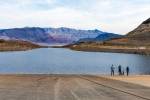Upper basin states take notice
DENVER -- The four upper basin states that use Colorado River water have a big stake in the success of a proposal for managing the river, especially as the region's drought drags on, negotiators and water managers say.
The upper basin states -- Colorado, Utah, Wyoming and New Mexico -- already are struggling with drought and could face cutbacks if they and other users of the river water in Arizona, California and Nevada fight rather than cooperate, said Jim Lochhead, an attorney representing several Colorado water districts and communities.
The seven states hope that an agreement they signed last week after months of negotiations will be adopted by the Interior Department to help manage the Colorado River.
The Interior Department is considering guidelines for dealing with water shortages. The guidelines would update a 1922 compact laying out the states' shares of water from the river that starts in the Never Summer Range of the Rockies in north-central Colorado.
Arizona, California, Nevada and, under a treaty, Mexico are guaranteed a certain amount of river water every year.
The upper basin states, so called because of their geography, divvy up the rest, which the states say isn't as much as estimated when the compact was approved.
The proposal would allow the upper basin to deliver less water during droughts and includes incentives for conservation, improved efficiency and ways for users to bank water in the reservoirs.
The Interior Department expects to issue a final environmental impact statement on the guidelines by year's end. The agency had encouraged states to come up with their own solution or face one imposed by the government.
"Colorado has a huge amount at stake in these negotiations primarily because if we are in a situation where we don't meet our compact obligations and are required to curtail uses, the first users in Colorado potentially affected are the whole Denver, Front Range municipal area," said Lochhead, one of the main negotiators.
The area's population is more than 3.6 million and growing. At least 30 million people in one of the country's fastest-growing regions depend on the Colorado River.
But rising demands and more than six years of drought are straining the system. Water managers are also grappling with the potential impacts of climate change, which could mean less moisture and unpredictable weather.
Under the compact, the upper basin states must deliver 75 million acre-feet every 10 years to the lower basin states.
In practice, at least 8.2 million acre-feet of water have been released annually from Lake Powell, the upstream reservoir in Utah, to Lake Mead in Nevada since the late 1960s, said Don Ostler, executive director of the Salt Lake City-based Upper Colorado River Commission.
California's share is 4.4 million acre-feet, although it used more when there were surpluses.
An acre-foot is about 326,000 gallons, which is almost enough water to supply two average Las Vegas homes for one year.
The rest of the water is split with Colorado getting 51.7 percent; New Mexico, 11.25 percent; Utah, 23 percent; and Wyoming, 14 percent. Mexico is due 1.5 million acre-feet a year.
The thought was that the upper basin would get about 7.5 million acre-feet a year. Ostler said the area can expect at least 6 million acre-feet most of the time.
"The upper basin deals with shortages routinely. They occur because a lot of upper basin uses occur on upper tributaries above the reservoirs," Ostler said.
The lower basin is feeling the pinch as the drought continues. Snowpack in the mountains, the major source of Colorado River water, has diminished.
The flow from the upper basin has dropped, ranging from 25 percent of average to 62 percent since 2000.
Ostler said this year's flow likely will be about 70 percent of average.
The states' plan sent to Interior Secretary Dirk Kempthorne is a significant step forward in dealing with the drought and rising demands, said Patrick Tyrrell, Wyoming state engineer.
"For the first time now, we have on record at least a way to approach shortages in the lower basin," Tyrrell said.
The proposal would also establish a process to head off lawsuits, said attorney Lochhead, the former head of the Colorado Department of Natural Resources.
"A lawsuit would kind of be like nuclear war. It would be the mother of all water lawsuits," Lochhead said.
The fight would end up in the U.S. Supreme Court, cost hundreds of millions of dollars and probably take 15 to 20 years, he added.
ON THE WEB Colorado River Interim Guidelines for Lower Basin Shortages and Coordinated Operations for Lakes Powell and Mead: www.usbr.gov /lc/region/programs /strategies.html




























